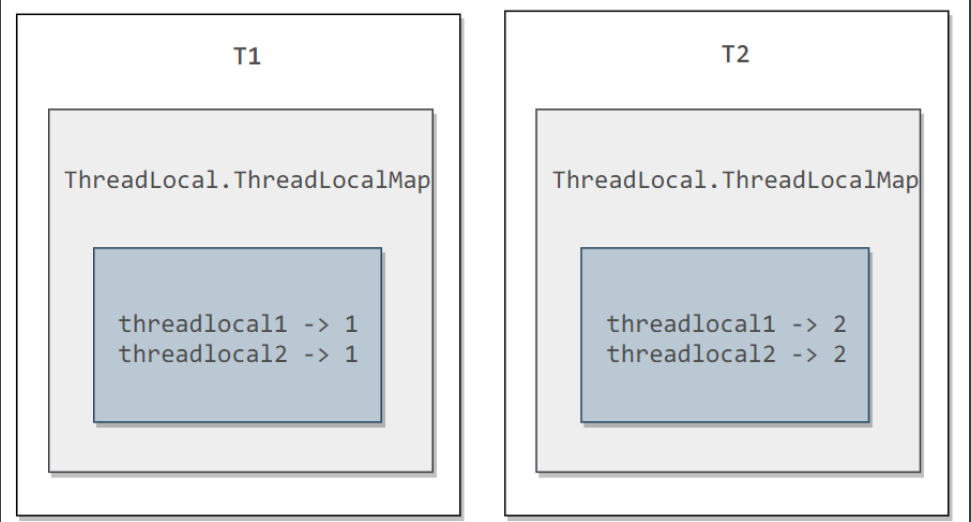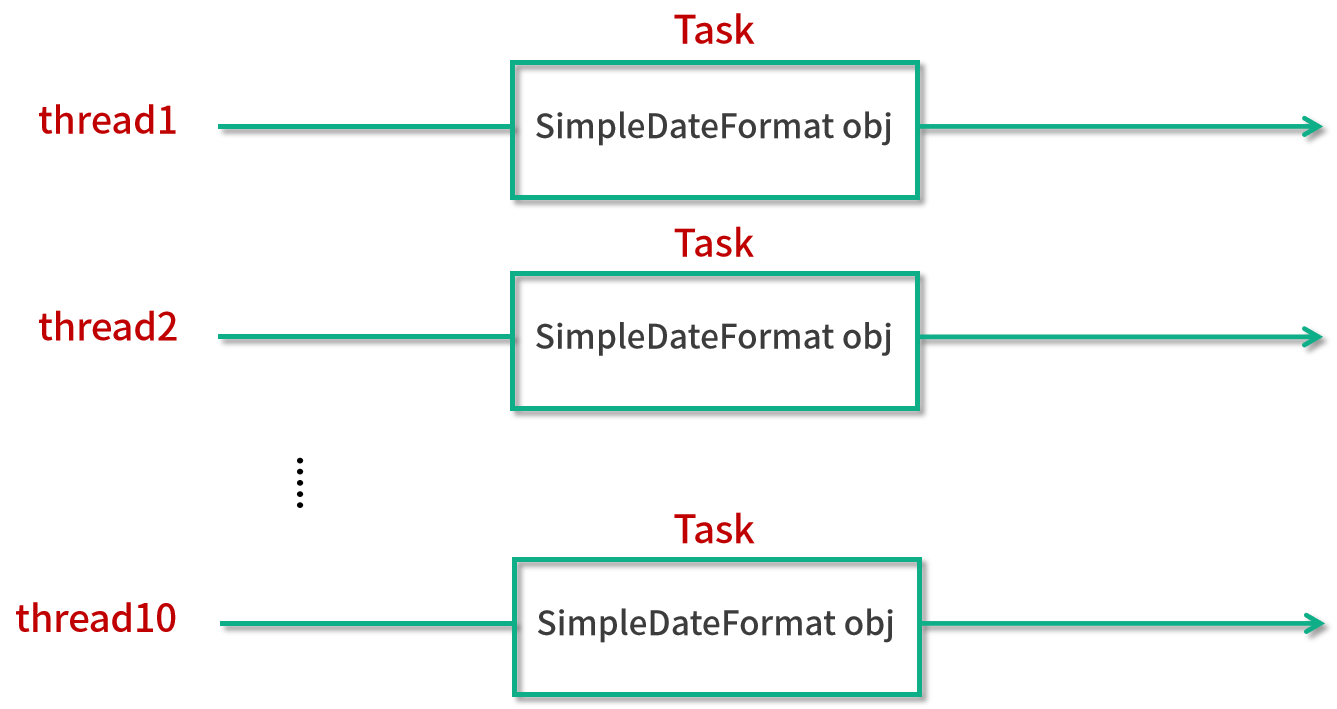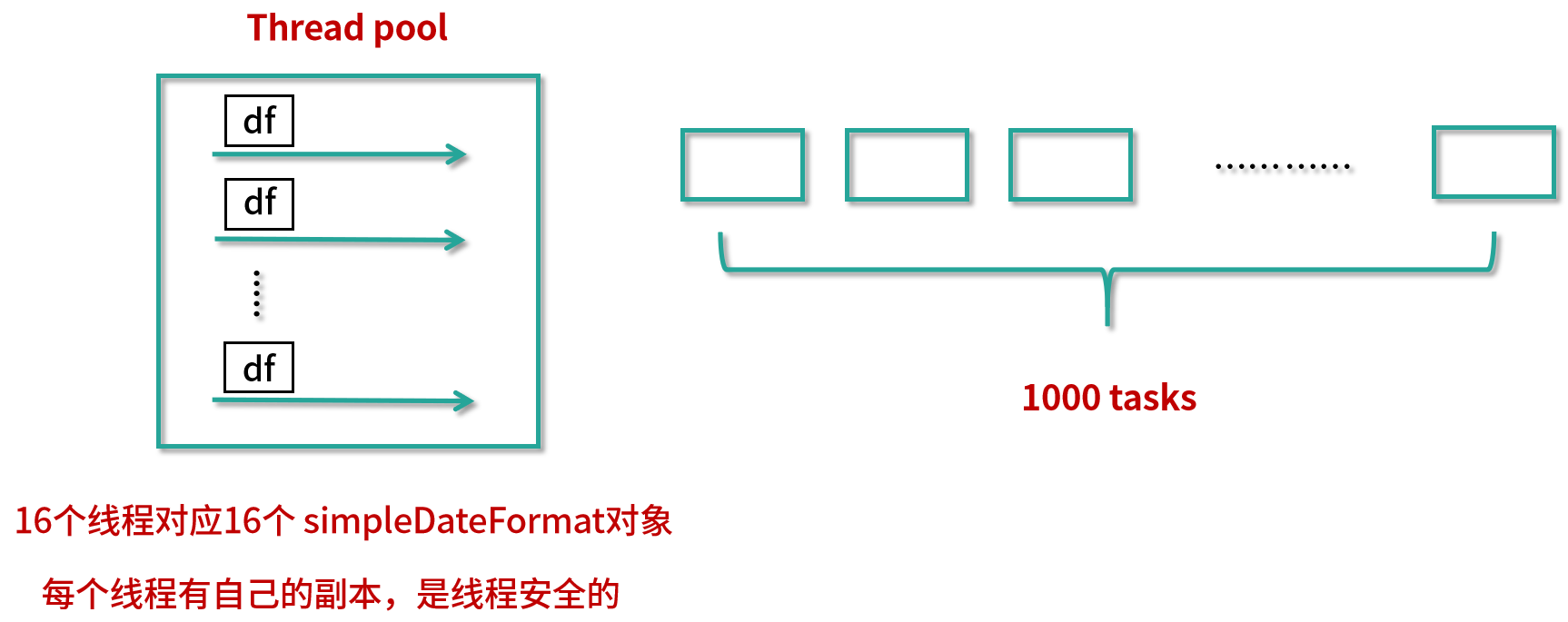底层结构
先看以下代码:
public static void main(String[] args) {ThreadLocal threadLocal1 = new ThreadLocal();ThreadLocal threadLocal2 = new ThreadLocal();Thread T1 = new Thread(() -> {threadLocal1.set(1);threadLocal2.set(2);System.out.println(Thread.currentThread().getName()+threadLocal1.get());System.out.println(Thread.currentThread().getName()+threadLocal2.get());});Thread T2 = new Thread(() -> {threadLocal1.set(3);threadLocal2.set(4);System.out.println(Thread.currentThread().getName()+threadLocal1.get());System.out.println(Thread.currentThread().getName()+threadLocal2.get());});T1.start();T2.start();}
它所对应的底层结构图为:
每个 Thread 都有一个 ThreadLocal.ThreadLocalMap 对象。
当调用一个 ThreadLocal 的 set(T value) 方方法时,先得到当前线程的 ThreadLocalMap 对象,然后将
ThreadLocal->value 键值对插入到该 Map 中。
public void set(T value) {Thread t = Thread.currentThread();ThreadLocalMap map = getMap(t);if (map != null)map.set(this, value);elsecreateMap(t, value);}
get() 方法也是先获得当前线程,然后获取当前线程的ThreadLocalMap,然后传入ThreadLocal来获得值。
应用场景一
ThreadLocal 用作保存每个线程独享的对象,为每个线程都创建一个副本,这样每个线程都可以修改自己所拥有的副本, 而不会影响其他线程的副本,确保了线程安全。
这种场景通常用于保存线程不安全的工具类,典型的需要使用的类就是 SimpleDateFormat。
在这种情况下,每个Thread内都有自己的实例副本,且该副本只能由当前Thread访问到并使用,相当于每个线程内部的本地变量,这也是ThreadLocal命名的含义。因为每个线程独享副本,而不是公用的,所以不存在多线程间共享的问题。
比如有10个线程都要用到SimpleDateFormat
public class ThreadLocalDemo01 {public static void main(String[] args) throws InterruptedException {for (int i = 0; i < 10; i++) {int finalI = i;new Thread(() -> {String data = new ThreadLocalDemo01().date(finalI);System.out.println(data);}).start();Thread.sleep(100);}}private String date(int seconds){Date date = new Date(1000 * seconds);SimpleDateFormat simpleDateFormat = new SimpleDateFormat("mm:ss");return simpleDateFormat.format(date);}}
我们给每个线程都创建了SimpleDateFormat对象,他们之间互不影响,代码是可以正常执行的。输出结果:
00:0000:0100:0200:0300:0400:0500:0600:0700:0800:09
我们用图来看一下当前的这种状态:
如果有1000个线程都用到SimpleDateFormat对象呢?
我们一般不会直接去创建这么多线程,而是通过线程池,比如:
public class ThreadLocalDemo011 {public static ExecutorService threadPool = Executors.newFixedThreadPool(16);public static void main(String[] args) throws InterruptedException {for (int i = 0; i < 1000; i++) {int finalI = i;threadPool.submit(() -> {String data = new ThreadLocalDemo011().date(finalI);System.out.println(data);});}threadPool.shutdown();}private String date(int seconds){Date date = new Date(1000 * seconds);SimpleDateFormat simpleDateFormat = new SimpleDateFormat("mm:ss");return simpleDateFormat.format(date);}}
可以看出,我们用了一个16线程的线程池,并且给这个线程池提交了1000次任务。每个任务中它做的事情和之前是一样的,还是去执行date方法,并且在这个方法中创建一个simpleDateFormat 对象。结果:
00:0000:0700:0400:02...16:2916:2816:2716:2616:39
我们刚才所做的就是每个任务都创建了一个 simpleDateFormat 对象,也就是说,1000 个任务对应 1000 个 simpleDateFormat 对象,但是如果任务数巨多怎么办?
这么多对象的创建是有开销的,并且在使用完之后的销毁同样是有开销的,同时存在在内存中也是一种内存的浪费。
我们可能会想到,要不所有的线程共用一个 simpleDateFormat 对象?但是simpleDateFormat 又不是线程安全的,我们必须做同步,比如使用synchronized加锁。到这里也许就是我们最终的一个解决方法。但是使用synchronized加锁会陷入一种排队的状态,多个线程不能同时工作,这样一来,整体的效率就被大大降低了。有没有更好的解决方案呢?
使用ThreadLocal
对这种场景,ThreadLocal再合适不过了,ThreadLocal给每个线程维护一个自己的simpleDateFormat对象,这个对象在线程之间是独立的,互相没有关系的。这也就避免了线程安全问题。与此同时,simpleDateFormat对象还不会创造过多,线程池一共只有 16 个线程,所以需要16个对象即可。
public class ThreadLocalDemo04 {public static ExecutorService threadPool = Executors.newFixedThreadPool(16);public static void main(String[] args) throws InterruptedException {for (int i = 0; i < 1000; i++) {int finalI = i;threadPool.submit(() -> {String data = new ThreadLocalDemo04().date(finalI);System.out.println(data);});}threadPool.shutdown();}private String date(int seconds){Date date = new Date(1000 * seconds);SimpleDateFormat dateFormat = ThreadSafeFormater.dateFormatThreadLocal.get();return dateFormat.format(date);}}class ThreadSafeFormater{public static ThreadLocal<SimpleDateFormat> dateFormatThreadLocal = ThreadLocal.withInitial(() -> new SimpleDateFormat("mm:ss"));}
应用场景二
每个线程内需要保存类似于全局变量的信息(例如在拦截器中获取的用户信息),可以让不同方法直接使用,避免参数传递的麻烦却不想被多线程共享(因为不同线程获取到的用户信息不一样)。
例如,用 ThreadLocal 保存一些业务内容(用户权限信息、从用户系统获取到的用户名、用户ID 等),这些信息在同一个线程内相同,但是不同的线程使用的业务内容是不相同的。
在线程生命周期内,都通过这个静态 ThreadLocal 实例的 get() 方法取得自己 set 过的那个对象,避免了将这个对象(如 user 对象)作为参数传递的麻烦。
比如说我们是一个用户系统,那么当一个请求进来的时候,一个线程会负责执行这个请求,然后这个请求就会依次调用service-1()、service-2()、service-3()、service-4(),这4个方法可能是分布在不同的类中的。
我们用图画的形式举一个实例:
package com.kong.threadlocal;public class ThreadLocalDemo05 {public static void main(String[] args) {User user = new User("jack");new Service1().service1(user);}}class Service1 {public void service1(User user){//给ThreadLocal赋值,后续的服务直接通过ThreadLocal获取就行了。UserContextHolder.holder.set(user);new Service2().service2();}}class Service2 {public void service2(){User user = UserContextHolder.holder.get();System.out.println("service2拿到的用户:"+user.name);new Service3().service3();}}class Service3 {public void service3(){User user = UserContextHolder.holder.get();System.out.println("service3拿到的用户:"+user.name);//在整个流程执行完毕后,一定要执行removeUserContextHolder.holder.remove();}}class UserContextHolder {//创建ThreadLocal保存User对象public static ThreadLocal<User> holder = new ThreadLocal<>();}class User {String name;public User(String name){this.name = name;}}
执行的结果:
service2拿到的用户:jackservice3拿到的用户:jack


